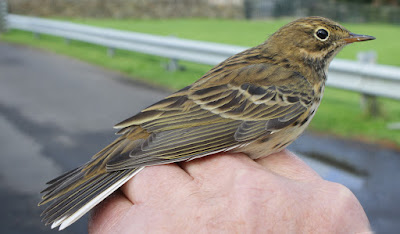June is a quiet month for both birding and ringing. Many birders hang up their bins for a month and take a well-earned respite from the 'ping-ping' of WhatsApp messages. Ringers carry on through the quiet days knowing that although catches may be small, the data they collect is vital, more so if they have nest boxes to process.
June is the period when young and recently fledged birds begin to discover their surroundings and the local area, learning it well enough so as to return to the same location next year. It’s a little like human infants that once having learnt how to crawl on all fours then begin to explore the small world around them in ever expanding circles. While human young take months and years to learn the ropes and to gain their independence, most young birds have just weeks before they head off alone to far flung places.
With such thoughts in mind I set off to meet Andy at Oakenclough for a bright and sunny start. Unless we hit a freakish patch we knew the morning would be quiet, and with luck, our catch into double figures.
So it proved with just 13 caught - 3 Blackcap, 2 Willow Warbler, 2 Wren, 2 Great Tit, 1 Blue Tit, 1 Robin, 1 Goldcrest, 1 Dunnock .
Ten of the thirteen were young birds of the year. The three adults caught were those recently breeding on site - a male Willow Warbler first caught here on 22 April 2020 and two new male Blackcaps.
Blackcap - adult male
Willow Warbler - juvenile
Young Goldcrests show zero colouration on the crown, unlike adults that are sexed according to the colour of their crown feathers.
Goldcrest - juvenile
The morning’s hatch of insects brought in p to eight Swifts and several Swallows aerial feeding around us. Otherwise birding was unspectacular apart from a Cuckoo that called as it patrolled the edge of a nearby plantation.
And now for Sunday afternoon - Father’s Day. We await the arrival of kidsand grandkids bearing gifts that might include a bottle or two.
That’s Sunday evening sorted.
Back soon with more birding and ringing from Another Bird Blog. Maybe next week we’ll get the much promised heatwave?















































































